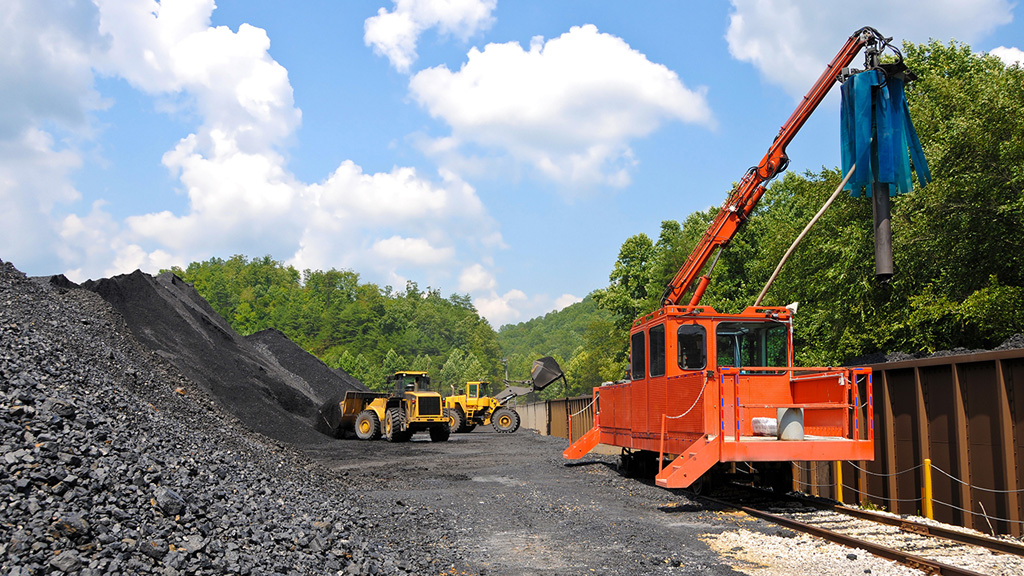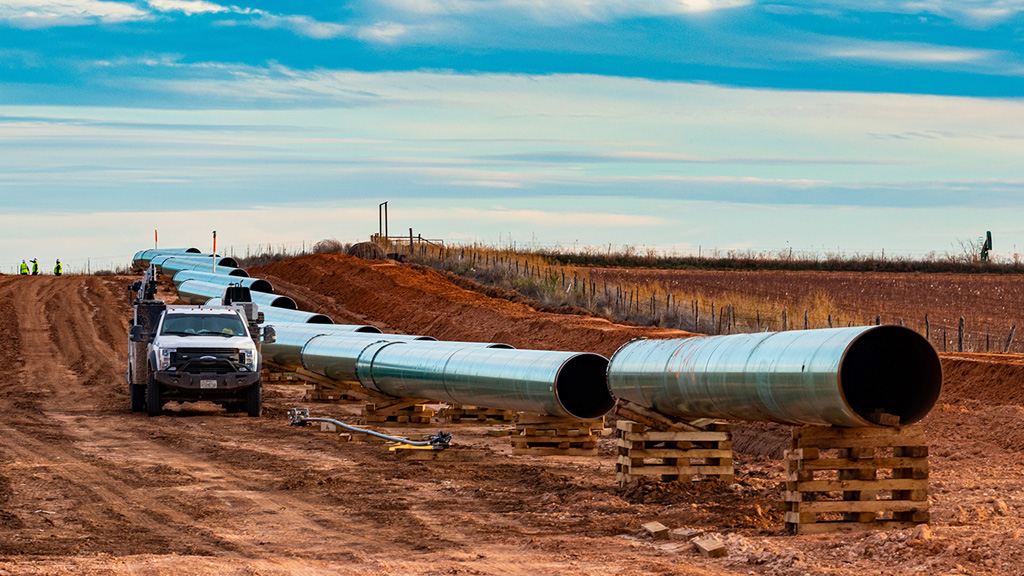Fossil Fuels
Combustibles Fósiles

Trucks loading coal into rail cars
Camiones que cargan carbón en vagones
English | LEVEL A

Trucks loading coal into rail cars
Camiones que cargan carbón en vagones
Fossil fuels are like buried treasures! They come from the remains of plants and animals that lived millions of years ago. These remains were buried deep underground and, over time, turned into fuels we use today. The three main fossil fuels are coal, oil, and natural gas.
We use fossil fuels every day! They help us make electricity, power cars, and heat our homes. Even plastic is made from fossil fuels. Fossil fuels give us a lot of energy and are easy to move around, which is why people have used them for so long.
To move fossil fuels, people use pipelines. Pipelines are like giant underground straws that carry oil and gas across the country. This is a safe and fast way to move fuels without needing lots of trucks or trains.

Oil pipeline being installed in West Texas
Se instala oleoducto en el oeste de Texas
But fossil fuels are nonrenewable. This means that once we use them, they are gone. They take millions of years to form, so we can’t make more quickly. That’s why we need to save them and use energy from the sun and wind too.
Texas is a great place to find fossils! A long time ago, much of Texas was under an ocean. When sea animals died, their shells and bones sank to the ocean floor and became fossils. Some of these fossils turned into fossil fuels like oil and gas.
In Texas, you can find fossils of sea creatures like ammonites with spiral shells and shark teeth. Texas is also famous for dinosaur footprints found in the Paluxy River. Another exciting fossil found in Texas is the woolly mammoth. These animals looked like elephants with long tusks and thick fur.
There are also plant fossils in Texas. Long ago, forests and swamps covered the land. When plants like ferns and trees died, they sometimes became fossils. Some even helped form coal, a type of fossil fuel.
Fossils and fossil fuels help us learn about the past. Scientists are working on better ways to move oil and gas safely and finding new energy sources. By using less fossil fuel, we can make it last longer and take care of our planet!
¡Los combustibles fósiles son como tesoros enterrados! Provienen de los restos de plantas y animales que vivieron hace millones de años. Estos restos fueron enterrados a gran profundidad y, con el tiempo, se convirtieron en los combustibles que utilizamos hoy en día. Los tres principales combustibles fósiles son el carbón, el petróleo y el gas natural.
¡Usamos combustibles fósiles a diario! Nos ayudan a generar electricidad, impulsar automóviles y calentar nuestros hogares. Incluso el plástico se fabrica a partir de combustibles fósiles. Los combustibles fósiles nos proporcionan mucha energía y son fáciles de transportar, por lo que se han utilizado durante tanto tiempo.
Para transportar combustibles fósiles, se utilizan oleoductos. Los oleoductos son como gigantescos tubos subterráneos que transportan petróleo y gas por todo el país. Es una forma segura y rápida de transportar combustibles sin necesidad de muchos camiones o trenes.

Oil pipeline being installed in West Texas
Se instala oleoducto en el oeste de Texas
Pero los combustibles fósiles no son renovables. Esto significa que una vez que los usamos, se agotan. Tardan millones de años en formarse, así que no podemos hacerlos más rápido. Por eso necesitamos conservarlos y también utilizar la energía del sol y el viento.
¡Texas es un lugar fantástico para encontrar fósiles! Hace mucho tiempo, gran parte de Texas estaba bajo el océano. Cuando los animales marinos morían, sus caparazones y huesos se hundían hasta el fondo del océano y se convertían en fósiles. Algunos de estos fósiles se convertían en combustibles fósiles como el petróleo y el gas.
En Texas, se pueden encontrar fósiles de criaturas marinas como amonitas con caparazones espirales y dientes de tiburón. Texas también es famoso por las huellas de dinosaurios encontradas en el río Paluxy. Otro fósil fascinante encontrado en Texas es el mamut lanudo. Estos animales parecían elefantes con largos colmillos y pelaje denso.
También hay fósiles de plantas en Texas. Hace mucho tiempo, los bosques y pantanos cubrían la tierra. Cuando plantas como helechos y árboles morían, a veces se convertían en fósiles. Algunas incluso contribuyeron a la formación de carbón, un tipo de combustible fósil.
Los fósiles y los combustibles fósiles nos ayudan a aprender sobre el pasado. Los científicos están trabajando en mejores maneras de transportar petróleo y gas de forma segura y encontrando nuevas fuentes de energía. Al usar menos combustibles fósiles, podemos prolongar su vida útil y cuidar nuestro planeta.
Fossil fuels are like hidden treasures found deep underground. Fossil fuels are sources of energy that come from the remains of ancient plants and animals. These remains were buried deep underground millions of years ago. Over time, heat and pressure turned them into fuels we use today. The three main types of fossil fuels are coal, oil, and natural gas.
People use fossil fuels every day. We burn them to make electricity, power cars, and heat our homes. Even plastic comes from fossil fuels. These fuels are very helpful because they provide a lot of energy, are relatively easy to transport and use, and have helped build modern society.
Once people dig them up, they need to be moved to places where they can be turned into things we use every day. One way that fossil fuels are transported is through pipelines. Imagine giant straws running underground. These are called pipelines, and they carry oil and gas across the United States. It’s a safe and fast way to move the fossil fuels without using big trucks or trains all the time.

Oil pipeline being installed in West Texas
Se instala oleoducto en el oeste de Texas
Fossil fuels are nonrenewable resources. This means they can run out. They take millions of years to form, so we can’t make more quickly. Because of this, it’s important to use less and find other ways to get energy, like from the sun and wind.
Texas is a great place to find fossils! A long time ago, much of Texas was covered by an ocean. Many sea animals lived there. When they died, their shells and bones sank to the ocean floor and were covered by mud. Over time, they became fossils. Many of these fossils turned into fossil fuels. Other fossils are not old enough yet.
Fossils of sea creatures like ammonites with spiraled shells, and shark teeth can be found in Central and West Texas. Texas is also famous for dinosaur fossils, including footprints found in the Paluxy River. Another exciting fossil found in Texas is the woolly mammoth. These giant animals lived during the Ice Age. Their fossils have been found in parts of North Texas. They looked like elephants with long, curved tusks and had thick fur to keep them warm. Many of these animal fossils became oil and gas.
There are also fossils of plants in Texas. A long time ago, forests and swamps covered parts of the state. When plants like ferns and ancient trees died, they sometimes got buried in mud. Over time, they turned into fossils. These plant fossils give clues about what the land looked like millions of years ago. Some of these ancient plants even helped form coal, one type of fossil fuel.
Fossils and fossil fuels are fun to study. Learning about them helps us understand the past – and take care of the future. Currently, scientists at the University of Texas are studying ways to improve oil and gas pipelines to reduce losing fuel during transportation. We are also all working on ways to reduce the use of fossil fuels so they last us as long as possible!
Los combustibles fósiles son como tesoros escondidos en las profundidades del subsuelo. Son fuentes de energía que provienen de los restos de plantas y animales antiguos. Estos restos fueron enterrados a gran profundidad hace millones de años. Con el tiempo, el calor y la presión los transformaron en los combustibles que utilizamos hoy en día. Los tres tipos principales de combustibles fósiles son el carbón, el petróleo y el gas natural.
Las personas utilizan combustibles fósiles a diario. Los quemamos para generar electricidad, impulsar automóviles y calentar nuestros hogares. Incluso el plástico proviene de combustibles fósiles. Estos combustibles son muy útiles porque proporcionan mucha energía, son relativamente fáciles de transportar y usar, y han contribuido a la construcción de la sociedad moderna.
Una vez que se extraen, es necesario trasladarlos a lugares donde se puedan convertir en productos de uso diario. Una forma de transportar los combustibles fósiles es a través de oleoductos. Imaginen unas pajitas gigantes que corren bajo tierra. Se llaman oleoductos y transportan petróleo y gas por todo Estados Unidos. Es una forma segura y rápida de transportar combustibles fósiles sin usar grandes camiones ni trenes constantemente.

Oil pipeline being installed in West Texas
Se instala oleoducto en el oeste de Texas
Los combustibles fósiles son recursos no renovables. Esto significa que pueden agotarse. Tardan millones de años en formarse, por lo que no podemos producir más rápidamente. Por eso, es importante usar menos y encontrar otras formas de obtener energía, como el sol y el viento.
¡Texas es un lugar fantástico para encontrar fósiles! Hace mucho tiempo, gran parte de Texas estaba cubierta por un océano. Muchos animales marinos vivían allí. Al morir, sus caparazones y huesos se hundían hasta el fondo del océano y quedaban cubiertos de lodo. Con el tiempo, se convertían en fósiles. Muchos de estos fósiles se convirtieron en combustibles fósiles. Otros fósiles aún no son lo suficientemente antiguos.
Se pueden encontrar fósiles de criaturas marinas como amonitas con caparazones en espiral y dientes de tiburón en el centro y oeste de Texas. Texas también es famoso por sus fósiles de dinosaurios, incluyendo huellas encontradas en el río Paluxy. Otro fósil fascinante hallado en Texas es el mamut lanudo. Estos animales gigantes vivieron durante la Edad de Hielo. Sus fósiles se han encontrado en partes del norte de Texas. Parecían elefantes, con colmillos largos y curvos, y tenían un pelaje grueso para mantenerse calientes. Muchos de estos fósiles animales se convirtieron en petróleo y gas.
También hay fósiles de plantas en Texas. Hace mucho tiempo, bosques y pantanos cubrían partes del estado. Cuando plantas como helechos y árboles antiguos morían, a veces quedaban enterradas en el lodo. Con el tiempo, se convertían en fósiles. Estos fósiles de plantas dan pistas sobre cómo era la tierra hace millones de años. Algunas de estas plantas antiguas incluso contribuyeron a la formación del carbón, un tipo de combustible fósil.
Estudiar los fósiles y los combustibles fósiles es divertido. Aprender sobre ellos nos ayuda a comprender el pasado y a cuidar el futuro. Actualmente, científicos de la Universidad de Texas están estudiando maneras de mejorar los oleoductos y gasoductos para reducir la pérdida de combustible durante el transporte. ¡También estamos trabajando todos en formas de reducir el uso de combustibles fósiles para que nos duren el mayor tiempo posible!